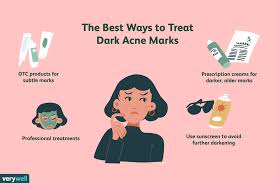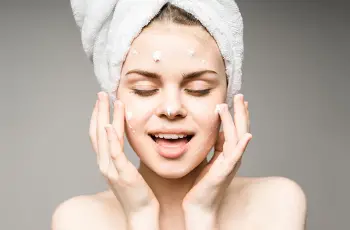
Inflammation Causes Hyperpigmentation
If your skin is easily reactive and prone to redness, flushing, or conditions such as rosacea, it is likely experiencing ongoing inflammation, which is one of the leading causes of many chronic skin concerns.
Inflammation can disrupt the skin barrier and trigger issues like dehydration, premature aging, and the formation of dark spots, making it essential to address inflammation in any effective skincare routine.
If you struggle with dark spots or uneven pigmentation, targeting inflammation is critical because it often leads to post-inflammatory hyperpigmentation (PIH) and conditions like melasma.
A skincare routine focused on calming the skin and reducing inflammatory responses will not only prevent pigmentation but also support overall skin health and resilience over time.
Learning which of the 16 Baumann Skin Types you belong to can help you better understand the underlying causes of your inflammation and guide you toward the best treatment plan for your skin.
How Inflammation Triggers Hyperpigmentation
Inflammation is a primary driver of hyperpigmentation, which is why dark spots frequently appear after acne, eczema, rashes, burns, or any other condition that injures or irritates the skin.
If your skin is sensitive or prone to inflammation, you are naturally at a higher risk of developing uneven pigmentation because your melanocytes are more likely to produce excess melanin.
Inflammation can result from a variety of different skin issues, including chronic conditions like rosacea or eczema, or even short-term irritants like harsh products or environmental stressors.
When inflammation occurs, the immune system becomes activated and releases chemical messengers that signal melanocytes, the pigment-producing cells in the skin, to create more melanin.
This overproduction of melanin leads to visible dark spots or patches, especially in individuals with skin that is already predisposed to pigment changes.
Darker Skin Types Have a Higher Risk
Fitzpatrick Skin Types III and above, which include medium to deep brown and black skin tones, have melanocytes that are more easily stimulated to create melanin pigment.
Because of this heightened melanin response, people with darker skin tones are more likely to experience dark spots or patches after any type of skin injury, irritation, or inflammation.
This risk is especially high for post-inflammatory hyperpigmentation, where the skin remains visibly darker in the affected areas long after the original trigger has resolved.
In darker skin, inflamed areas may sometimes be referred to as “black rashes” because the skin darkens as a result of inflammation and repeated scratching or rubbing of the affected areas.
For this reason, individuals with darker skin tones must be especially vigilant with sun protection, avoiding unnecessary irritation, and using gentle products in their skincare routines.
Scratching and Pigmentation Problems
When you scratch itchy or irritated skin, you are essentially creating a small injury, which sets off an inflammatory cascade that tells melanocytes to produce more melanin.
This increase in melanin production can lead to lasting hyperpigmentation even after the initial wound or irritation has completely healed, making treatment more challenging.
For people with darker skin tones, the pigmentation caused by scratching or rubbing can become particularly noticeable and stubborn, lasting months or even years.
Preventing this chain reaction requires using the right anti-inflammatory ingredients to reduce itchiness, calm irritation, and discourage scratching that damages the skin.
Products that soothe the skin not only help break the itch-scratch cycle but also lower your risk of hyperpigmentation from chronic inflammation and repeated trauma.
Eczema and Persistent Darkening
Eczema, also known as atopic dermatitis, is an inflammatory condition that causes severe itchiness and irritation, often leading to darkening of the skin in affected areas.
Because eczema flare-ups frequently involve scratching, the resulting injury combined with inflammation can leave behind hyperpigmentation long after the rash has subsided.
People with brown or black skin tones often experience especially noticeable dark patches where eczema flare-ups have occurred, which may persist for a long time.
Treating these darkened areas effectively requires a dual approach: using targeted eczema treatments to control inflammation and skin-lightening products to fade pigmentation.
Ignoring the pigmentation issue can allow dark spots to worsen over time, which is why a comprehensive treatment plan is critical for eczema sufferers with darker skin tones.
Dark Skin and Rashes
Any type of rash can leave behind lingering hyperpigmentation in individuals with darker skin tones, especially when scratching or rubbing worsens inflammation.
This is why understanding the root cause of your inflammation and taking steps to control it as early as possible is essential to protecting your skin’s overall appearance.
Know Your Skin Type
The first step in treating inflammation-related pigmentation is identifying what is causing your skin to be reactive, sensitive, and prone to inflammation in the first place.
Common triggers include acne, allergic reactions, dryness, eczema, psoriasis, rosacea, over-exfoliation, sun sensitivity, and even the use of incorrect skincare products.
Many people unknowingly worsen their own inflammation by using harsh cleansers, excessive exfoliants, or active ingredients that are unsuitable for their unique skin type.
This is exactly why taking a skin type quiz can be invaluable, as it provides personalized insights into your skin’s needs and helps you build a proper routine.
The Baumann Skin Type Quiz identifies you as one of 16 skin types and provides educational materials, product recommendations, and reviews from people with the same type.
You can also join communities such as Reddit’s r/skintypesolutions to connect with others who share your skin type and learn from their product experiences.
Products That Target Inflammation and Pigmentation
If you have both sensitive, inflamed skin and dark spots, you need products that contain ingredients capable of calming inflammation while also reducing melanin production.
One dermatologist-developed option is Derma Made Azelaic Acid Cream 15%, which contains azelaic acid in a concentration almost as effective as the 20% prescription version.
Azelaic acid is a multifunctional ingredient that soothes inflammation, gently exfoliates the skin, and acts as a tyrosinase inhibitor to block excess melanin production.
Another great product is Vichy LiftActiv B3 Serum, which combines niacinamide and tranexamic acid to reduce both inflammation and pigmentation while also providing antioxidant protection.
This serum also includes Vitamin C, which brightens the skin and inhibits tyrosinase, and allantoin, which has a calming, soothing effect on inflamed or irritated skin.
SkinCeuticals Discoloration Defense is another excellent option, offering niacinamide and tranexamic acid to calm the skin, along with kojic acid to inhibit pigment production.
For advanced care, Alastin A-Luminate Brightening Serum uses high-tech ingredients to target inflammation, reduce melanin production, and improve the skin’s overall clarity.
This serum contains niacinamide, tranexamic acid, gallic acid, hesperidin, milk thistle extract, ashwagandha root extract, Vitamin C, and Alastin’s proprietary TriHex technology.
Building the Right Skincare Routine
A dermatologist-designed skincare routine to prevent dark spots focuses on three main categories: daily sunscreen, melanin-blocking products, and calming ingredients.
Sunscreen is non-negotiable because UV exposure worsens existing hyperpigmentation and can trigger new dark spots, particularly in those with darker skin tones.
Products that block melanin production or transfer, such as tyrosinase inhibitors and PAR-2 blockers, are crucial for preventing further darkening of the skin.
Soothing ingredients help reduce inflammation at its source, protecting the skin barrier and lowering the likelihood of developing post-inflammatory pigmentation.
Dermatologists often recommend layering these categories together, so the skin remains protected from UV, calm from irritation, and less prone to melanin overproduction.
Why Controlling Inflammation Matters Most
Reducing inflammation is the single most important step you can take to prevent hyperpigmentation because it directly disrupts the cycle that leads to dark spots.
If inflammation is not controlled, it becomes difficult to address other aspects of skin health since chronic inflammation damages the barrier and accelerates skin aging.
A proper skincare routine tailored to your Baumann Skin Type will include the right combination of calming, brightening, and protective products to address your unique needs.
By customizing your routine, you can better control inflammation, prevent post-inflammatory hyperpigmentation, and support healthier, more even-toned skin over time.
Final Thoughts
Whether you are dealing with acne, eczema, rashes, or simple sensitivity, inflammation can easily lead to stubborn hyperpigmentation if it is not managed properly.
By taking steps to understand your skin type, using soothing products, and focusing on preventative care, you can protect your skin from long-term pigment changes.
Take the Baumann Skin Type Quiz to receive personalized recommendations and build a routine designed specifically to combat inflammation and hyperpigmentation.
The right approach can break the cycle of irritation and dark spots, leaving your skin healthier, more even, and more resilient in the long run.


